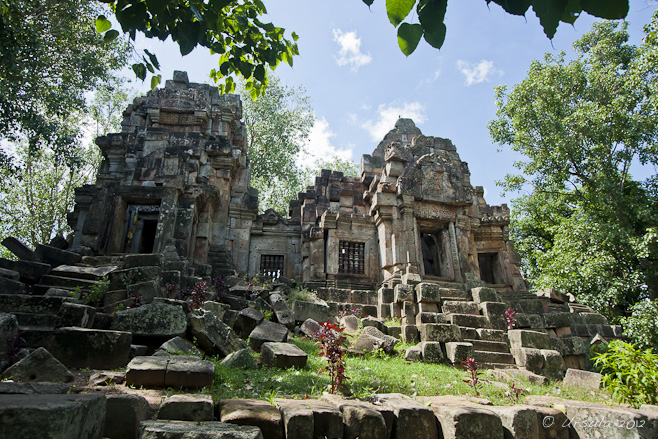 The ruins of Wat Ek Phnom in the afternoon light. Khmer ruins are just magic!
Moss and lichen make their homes on the piles of tumbled stones, trees grow up and through fallen buildings, holding walls together with their roots, light and shadow play across the whole scene.
Wat Ek Phnom, just outside Battambang, may not be the best known of the Angkor ruins, but it is a popular spot for Cambodians to pay their respects and to picnic. And after a day of smiling ’till my face hurt while taking people-pictures, I found the ruins a wonderful sanctuary of quiet and calm.
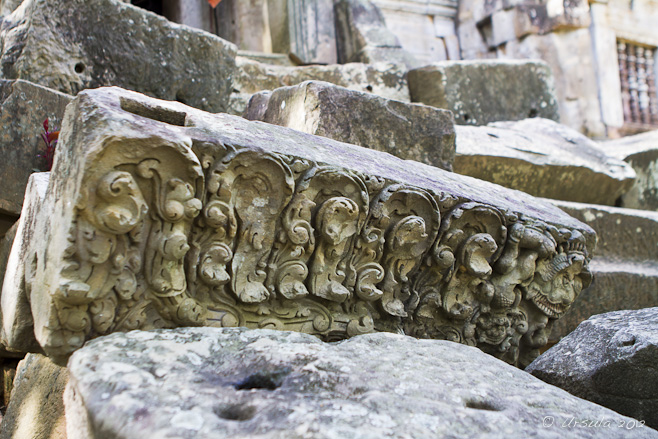 Richly decorated building bricks lie in a tumbled heap. 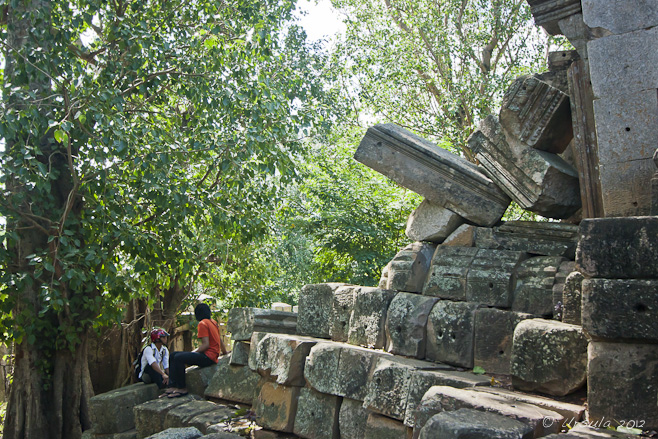 Khmer visitor to Wat Ek Phnom sit among the ruins. One of the beauty of these more remote sites is that you are free to clamber over the rubble and through the remains, unhindered by scaffolding or warning signs.
 Looking out the doorway...  From the old ruins ~ to the new Wat.  As with elsewhere in Cambodia, the modern practice of animist traditions is maintained in the form of colourful spirit houses.  The new Wat Ek Phnom is on the same site.  Mythical roosters decorate the banisters of the new wat.  It's as if the young monks just sit around, waiting for the light to fall and the tourists with cameras to come...  Young monks.  A new hall full of Buddhas and Abbots.  Guardians at the gate... According to the Lonely Planet: “Construction of the giant Buddha statue next door has been stopped by the government because, they say, it mars the site’s timeless beauty.” This is interesting, because the giant Buddha looked pretty finished to us.
 The giant Buddha at Wat Ek Phnom looked finished against the incoming weather.  Standing watch.  Life on the ground: a butterfly in the cosmos.  Buddha in the clouds : Wat Ek Phnom  There is an afternoon storm coming - time to leave Wat Ek Phnom.  Truly, the quiet before the storm! As the tropical clouds rolled in with amazing speed, we clambered into our tuk-tuks, hoping to make it back to the hotel safe and dry. Truly, the quiet before the storm! As the tropical clouds rolled in with amazing speed, we clambered into our tuk-tuks, hoping to make it back to the hotel safe and dry.
One out of two is not bad. 🙂
Safe travels.
Photos: 23 July 2011
Posted in Cambodia,Every Day Life,History,Nature,Religious PracticeTags: architecture,blog,buddhism,Cambodia,Khmer,monk,people,Photo Blog,religion,ruins,rural,sculpture,temple,travel,Travel Blog,Ursula Wall,worship
 They Go Up, Tiddly, Up, Up.  They Go Down, Tiddly, Down, Down.  Up! Down! Flying Around. Looping The Loop And Defying The Ground. What a treat!
We had headed out to Merimbula Airport, a small, single-runway regional airport in coastal south-eastern NSW, to see ‘Connie’, the Lockheed Super Constellation VH-EAG (Southern Preservation).
The development of these large, four-engined propeller-driven planes was financed and influenced by Howard Hughes, who wanted them for his airline TWA. Lockheed built 856 aircraft in the Constellation range between 1943 and 1958. As well as being sold to TWA and a number of other commercial airlines (including QANTAS), they were U.S. military air transport and U.S. President Dwight D. Eisenhower’s Air Force One.
Constellations were the world’s first pressurised commercial airliner. With their roominess and range, the 40-passenger transcontinental Connies revolutionised air travel in the 1940s and 1950s. Qantas used them on their famous Kangaroo Route between Australia and Great Britain from 1947. By 1954, Qantas had moved up to Super Constellations: “On 14 January 1958, two Super Constellations took off from Melbourne to inaugurate a pioneering round the world service. One travelled via India along the Kangaroo Route, while the other flew eastward on the Southern Cross Route via the United States.”
When we arrived at the airfield, the restored Connie – the last Constellation still air-worthy – was sitting on on the tarmac preparing for visitors. The Roulettes, the Royal Australia Air Force aerobatics team, on the other hand, were in the air.
As the Ron Goodwin song (with inspiration from Lorraine Williams) puts it: “Those magnificent men in their flying machines… enchant all the ladies and steal all the scenes!” As it happens, the Roulettes’ flyers were all men, and they and their Pilatus PC-9/A two-seat single-engine turboprops certainly commanded the attention of the crowd.
The Connie was pretty much ignored until the Roulettes were parked and de-planed.
 Up!  Down!  Flying Around.  They Enchant All The Ladies...  And Steal All The Scenes! (Roulettes Squadron Leader Stephen Baker)  The Roulettes at rest...  ... clearing the way for the scheduled Rex SAAB 340 to taxi out.  The RAAF rescue helicopter is on hand, just in case.  Queue for the Connie  A member of the HARS acts as gatekeeper. The Connie is lovingly flown and shown by members of HARS, the Historical Aircraft Society, who found the derelict ex-US Airforce plane in 1990. They spent a lot of money and volunteer-people-hours restoring it before flying it to Australia, in bunny-hops, in 1996.
 "CONNIE" in her QANTAS colours.  Another HARS volunteer greets people on the stairway.  One of the four oil-hungry 18-cylinder radial Wright R-3350 engines.  The navigator on the Lockheed Super Constellation has a whole room of knobs and dials...  ... as do the pilot and co-pilots.  The interior of the Lockheed Super Constellation was configured with more spaciousness than today's passenger planes.  The Connie's emergency exit was fitted with a length of rope instead of a slide raft.  Connie, shake your tail feathers! The Constellations were distinguishable by their triple-tail design.  From inside the Connie, an Australian-made Jabiru J120 looks even smaller!  Not all aircraft get restored.  ... and still they queue ...  Dear old Connie! Dear old Connie!
Representative of a rich and varied history, and still fuelling the dreams of those magnificent men and women who maintain and fly her.
Happy landings!
Posted in Australia,Aviation,MuseumTags: aircraft,airforce,airplane,airshow,blog,people,Photo Blog,portrait,portraits,travel,Travel Blog,Ursula Wall
It doesn’t matter what continent you are on: there is something about mountain air that sharpens the senses. Colours are brighter, the air is cleaner, sounds are clearer… I know my spirits rise.
Add to that: sunshine, a crisp Australian sparkling white wine, and some spirited jazz musicians, and you have an unbeatable experience. Last weekend we were in Thredbo, high in Australia’s Snowy Mountains, for the annual Jazz Festival: Thredbo’s 25th and our first.
Although I was introduced to Herbie Hancock and Thelonious Monk at an early age, “pure” jazz is not my favourite musical form. But, I’m always happy for an excuse (as though one is needed!) to head into Kosciuszko National Park, and we enjoyed the Blues Festival there greatly in January, so we decided to try it out. I’m not about to wade into the debate over what constitures the boundaries of “jazz”: suffice it to say, we were pleased (and a little relieved) to find great music in a variety of styles within the broader definitions.
Whatever you want to call it, it was pure fun and great entertainment.
The challenge for me, in tight corners and badly-lit venues, was to stop foot-tapping long enough to take a few pictures I’d could edit to the point where I’d be happy enough to share them – when I’d rather be dancing!
 Bright daylight outside, as we sit in a dimly lit bar, listening to the smooth voice of James Valentine. Our first stop was the Lounge Bar for the James Valentine Quartet. Now, as a “mum”, I know James’ voice from watching afternoon television with my children, some twenty-five years ago. Other people know him as the lead voice and tenor saxophone for the The James Valentine Quartet, a role he performs with effortless style.
 Gary Daley on accordion, with James Valentine  Smoky bar atmosphere ... without the smoke! We would have stayed for more, but we had dinner reservations with Sarah McKenzie, her keyboard and her band.
 Sarah McKenzie; what can I say, except that her bio doesn't exaggerate! We went home with an excellent CD.  Sarah McKenzie at the Cascades Restaurant  Drummer with the Sarah McKenzie Quartet.  Pick a beer - any beer. Cascade's Restaurant, Thredbo Alpine Hotel. After a morning run around the over-full Lake Jindabyne (we’ve had a LOT of rain here), we headed back up the hill the next afternoon to stake out a good position in the Schuss Bar.
 The Schuss Bar is ready and waiting...  ... for the Hot Potato Band ...  ... with its big, brassy sound.  Big vocals.  Rocking the saxophone.  Blue jeans and sax.  Bernie Lagana, playing the audience. With a smile on our faces, we danced off to another venue, dinner, and a completely different (but equally enjoyable) take on “jazz” from the flamboyant Jeff Duff, with Glenn Rhodes on keyboard and ex-Icehouse drummer Paul Wheeler.
 Jeff Duff chatting to a fan. One of the advantages of impossibly small venues is that one is privy to all the "back-stage" joys and dramas that go on behind any performance.  Paul Rhodes and his keyboard. We started our next day poolside, with pizza, that sunshine and white wine I mentioned earlier, and two lively groups of horns. The first, Shirazz from Melbourne, are self-described as a “trad jazz and dixieland band specialising in classic hot jazz of the 20s and 30s”. We bought a CD and have bopped around the living room all week.
 Matt Dixon, leader of the six-piece Shirazz, on trombone.  Shirazz with "Midnight in Moscow". (Mike di Cecco on drums and Alistair Robertson on double bass.)  Michael Hanley on banjo...  ... Davis Woods on trumpet.  Swing dancers take advantage of the sun and sounds. Poolside, Thredbo Alpine Hotel.  Simon Ghali and Mitchell Brandman herald the arrival of the Hot Potato Band.  Andrew Grant, with his trumpet, on the roof of the Thredbo Alpine Hotel.  Bernie Lagana playing the crowd - again! We headed back indoors for three more, very different definitions of “jazz”: The Date Brothers with their gypsy jazz guitars and Dan Barnett with his crooning swing, both in the Schuss Bar, before closing out our weekend with the hot jazz-boogie of The Shuffle Club in the Lounge Bar.
 The Date Brothers and their "Gypsy Jazz Guitar" sounds.  Since 2002, Ian Date has been based in Ireland, where he has clearly been gifted with the blarney.  Dan Barnett with his band.  As the lights come on outside, The Shuffle Club heat up the room.  If that is all jazz, I like it! If that is all jazz, I like it!
‘Till next time – keep smiling!
Posted in Australia,Music,PortraitsTags: Australia,blog,music,musicians,people,portraits,travel,Travel Blog,Ursula Wall
“The mosquitos are our friends.”
These were the words of Beatrix, our pranayama (breathing exercise) teacher as we sat in a small, hot, darkening room in Nong Khai, Northern Thailand. Her voice embodied calm, as only a yogini’s can, as it floated through the buzzing, humming, mosquito-filled evening.
These words spun around my head as I sat in an open wooden boat, motoring up the Mekong River some four or five days later, wrapped tightly in my arms and my pashmina shawl, trying to contain the violent shivers wracking my body. Mosquitos may be our friends, but they are also friends with malaria, dengue, and other hemorrhagic fevers… and it was looking increasingly as if I had contracted one of these. But, who knew when I might have another chance to visit the wilds of Laos and I had already paid for my day trip! So, I popped another aspirin against the pounding headache (in retrospect, the worst thing you can do in the tropics) and desperately tried to stay out of the wind.
This was two years ago: March 2010. I had been looking forward to visiting Laos after a week at the Nong Khai Yoga Retreat. My husband was meant to meet me in Luang Prabang, but got called to China at the last minute. I love travelling and I don’t mind travelling on my own, but it makes getting sick (or other hassles) harder to deal with. On this occasion, I managed to stay semi-upright long enough to finish the tour, taking a number of photographs along the way, before collapsing in the room of my guesthouse for two days, only surfacing to catch my plane to Bangkok and go back to bed for another week.
This is the first chance I’ve had to revisit that trip, and see what I can remember of it.
 The day started on a traditional wooden Mekong river boat, heading up stream... Our first stop was Ban Xhang Hai (or Ban Sang Hai, or Xanghai, depending on the transliteration system used), a small village north of Luang Prabang on the banks of the Mekong, known for making rice wine: with or without snakes and/or scorpions in it.
 Rice-wine seller, Ban Xhang Hai ... . . . . . . . . . . . . . . Scorpions in rice wine: sealed for your protection.  People still pan for gold on the Mekong River; I don't think they find much.  Gold Panners ~ Mekong River Twenty-five kilometres up-stream, at the confluence of the Mekong and Ou Rivers, we stopped at the Pak Ou Caves, which sit high above us, nestled into the limestone cliffs.
 The long climb up from the Mekong River boats... . . . . . to the dark entry way into Pak Ou Caves. From time immemorial, these caves have been considered sacred. They were used for the worship of the river spirits until the arrival of Buddhism. For at least 600 years, the caves have been a site of Buddhist pilgrimage and worship for kings and commoners alike.
 The upper cave, Tham Phum, is in complete darkness until someone shines a flashlight.  Kids hang around while their carers sell incense and offerings. Over the years, the caves have been filled with Buddha images of all types and styles, some more than 300 years old. There are estimated to be more than 4000 in Tham Ting – the lower cave – alone. More open to the light and only 15 meters above the river, this smaller cave is more accessible.
 Tham Ting is the lower and smaller of the two caves at Pak Ou  Tham Ting is estimated to contain more than 4000 Buddha images, of all types and ages. Our next stop was the Khmu minority village of Ban Thapaene for a simple rice-noodle lunch and a browse through the markets. The Khmu were the original indigenous inhabitants of northern Laos, but now number about 500,000 around the world. Most of these are still in villages in Northern Lao, but there has been a significant community in California since the Vietnam war.
 Carved water-buffalo in the market stalls of Ban Thapaene. Following lunch, a short jungle walk led us past the Asiatic Black Bear Sanctuary which is home to more than 20 Asiatic black bears who have been rescued from the bile-harvesting trade. A joint project of the Australian and Lao governments, the sanctuary is funded by donations on site and through the Australian-based not-for-profit Free the Bears organisation. (I’m sure they’d love your support!)
 Play-Space: Asiatic Black Bear Sanctuary, Laos  "You with the sad face..." ... a rescued Asiatic black bear. Then onward, through more jungle, to the beautiful tiered waterfalls of Khuang Xi (or Kuang Si – that pesky transliteration again!).
 A monk on the pathway... . . . . . . . . to Khuang Xi Waterfalls  A low wooden bridge is part of the well-groomed pathway along side the river.  Travertine falls amid lush jungle.  The limestone ground gives the water a glorious colour...  ... and provide multiple little falls, up the whole length of Khouang Xi Waterfall.  Although the waters are quite cold,  many people took the opportunity to cool off from the jungle heat.  Last stop before home: another village.  Clearly a full and varied day out. Perhaps one day I’ll get back there – when I’m actually well enough to enjoy it! Clearly a full and varied day out. Perhaps one day I’ll get back there – when I’m actually well enough to enjoy it!
Photos: 26 March 2010
Posted in Culture,Every Day Life,Laos,Nature,Religious Practice,TravelTags: blog,boats,buddhism,children,Laos,National Park,nature,people,Photo Blog,religion,sculpture,travel,Travel Blog,Ursula Wall,worship
 Boats in Snug Cove  Breakfast on the Wharf (iPhone) It is off-season here in Eden.
The days are very quiet, and the evenings are even quieter. The kids are back at school and the humpback whales are feeding in Antarctica. The local caravan parks are almost empty of visitors and it’s easy to get a parking space on main street or an outside table at the cafes near the wharf.
We’ve just had several months’ supply of rain in little over a week, so the waves crashing on the beaches are yellowed and the usually clear-blue waters of the Sapphire Coast are muddy-looking from the silt washed down from the hills.
Last Sunday we decided to take advantage of the first sunny day in what seemed like ages. We rode our bicycles to the Eden’s wharf on Snug Cove and indulged in brunch before joining a scenic cruise on Twofold Bay.
I had been told to check in at ten o’clock, in case the Twofold Bay Discovery Cruise wasn’t going out, so I wandered down to the water’s edge while my breakfast was cooking to have a look.
 Fishing boats at rest ~ Snug Cove, Eden  Buoy in the quiet waters of Snug Cove  Cat Balou ~ a 16 metre catamaran designed for sight-seeing cruises.  Rosalind and Gordon, owner-operators of Cat Balou Cruises, make their boat ship-shape in readiness. The sun was shining and the water was calmer than it had been for several weeks: clearly the perfect weather to go out on the bay.
Twofold Bay, named for its two bights by George Bass, who passed this way in 1797/98 on his way to Bass Strait, is one of the deepest natural harbours in the world. Historically home to whaling stations, the area still pays tribute to the killer whales that used to assist in the hunt for humpbacks. Today, when the humpbacks make their annual migration, between September and November, they are tracked at a respectful distance by the sight-seeing boats.
This time of year we’d be lucky to spot some Australian fur seals, or possibly penguins or dolphins.
 A perfect day for taking pictures, as we leave Snug Cove.  Rocks, mussel farm and sailboats: truly a multi-functional space! Cattle Bay, Eden  Quarantine Bay, so named because a sailing ship with a smallpox epidemic on board took refuge here in the 1800s, is now home to the Amateur Fishing Club and the local yacht club.  Heading home from Boydtown Beach...  Seahorse Inn, started in 1843, was the centrepiece of Ben Boyd's eponymous Boydtown.  A Japanese-owned woodchip mill has operated at the south end of Eden's Twofold Bay since 1967.  Rocks at the mouth of Kiah Inlet. A family-owned whaling station here operated until 1930.  Edrom Lodge was built in 1910 for John Logan. The 28-room manor was modelled on his Scottish home. It later became a guest house, and then a prison farm. Now, it is managed by the Forestry Commission and operates as a group function facility, accommodating up to 70 people.  The vivid colours of Kiah Inlet.  A sea eagle circles over Kiah Inlet looking for fish.  The Naval munitions wharf at Kiah Inlet is used as a general loading dock...  ... and a fishing platform ...  Most months two ships sail to Japan, Taiwan or China, with 43,000 tonnes of wood chips each, to be turned into high quality paper products.  Boyd's Tower, the 19 1/2 meter sandstone tower built in 1846, can just be seen over the tumbled rocks of Red Point (South Head).  Ben Boyd built the tower to light the way for his whaling and merchant ships. The government said that if he lit it for his boats, he must light it for all boats - which he refused. So, it never operated as a lighthouse.  Some say the jagged red rocks of Red Point look like the face of a North American Indian.  Recreational boaters, sporting white zinc to protect from the sun, race through the waters of Red Point.  After a delightful two hours, we head home. Rosalind and Gordon, the owner-operators of Cat Balou Cruises, looked after us well and did their best to point out the one seal who was hiding under the dock. Aside from the seaeagle, and the usual cormorants and seagulls, we had no luck with the wildlife at all. We were, essentially, watching water.
But what views! We’d seen some of this coastline from the air, and it is just as magnificent from the water.
 Can you imagine what it will be like in the good season? Can you imagine what it will be like in the good season?
I can hardly wait!
Posted in Architecture,Australia,Nature,TravelTags: architecture,beach,blog,boats,fishing,fishing boats,National Park,nature,people,Photo Blog,travel,Travel Blog,Ursula Wall
« Older posts
Newer posts »
|

















 Truly, the quiet before the storm! As the tropical clouds rolled in with amazing speed, we clambered into our tuk-tuks, hoping to make it back to the hotel safe and dry.
Truly, the quiet before the storm! As the tropical clouds rolled in with amazing speed, we clambered into our tuk-tuks, hoping to make it back to the hotel safe and dry.

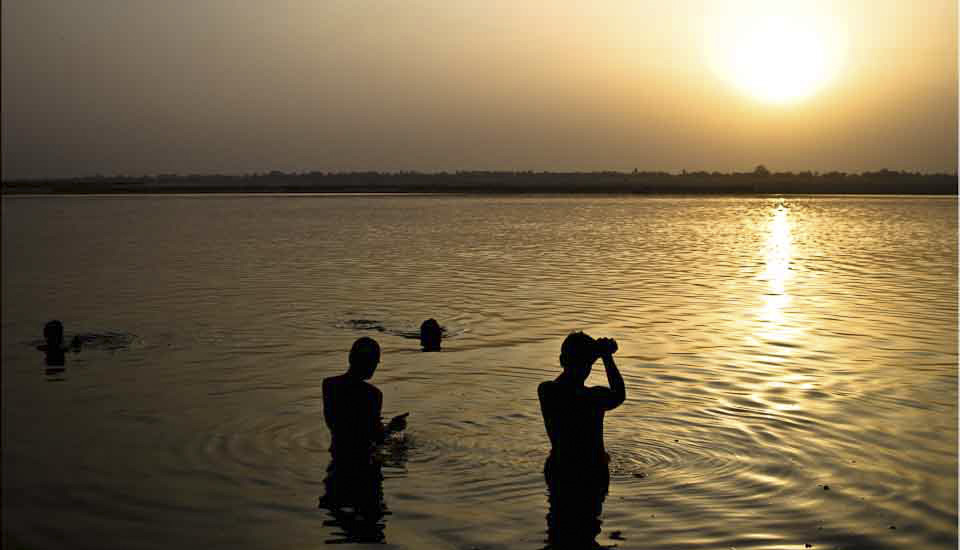

















 Dear old Connie!
Dear old Connie!























 If that is all jazz, I like it!
If that is all jazz, I like it!



























 Clearly a full and varied day out. Perhaps one day I’ll get back there – when I’m actually well enough to enjoy it!
Clearly a full and varied day out. Perhaps one day I’ll get back there – when I’m actually well enough to enjoy it!




















 Can you imagine what it will be like in the good season?
Can you imagine what it will be like in the good season?
























.png)
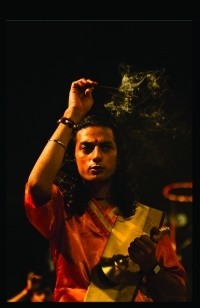
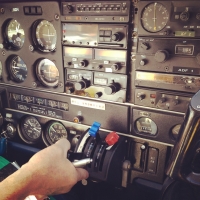
Beautiful images of a beautiful place – thank you.
Anna :o]
Thank YOU, Anna! :o]
ich habe wieder sehr genossen von dieser Serie. Liebe Grüsse, Dietmut
I’m so glad you enjoyed it, Dietmut. 🙂
as always, a pleasure to see where you’ve been
Thanks, Signe!